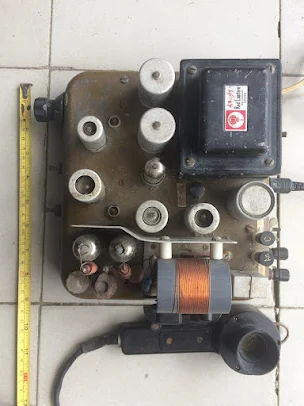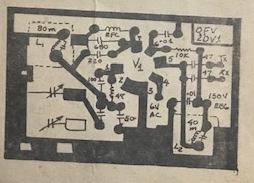Travelogue: Cuba DSB and AM. Jose CO6EC and the Islander. We need more info, especially on the solid state Jaguey rig.
Bill’s bench:
Will the High School DC receivers get finished? Future uncertain. But the project was technically interesting. Great working with Dean KK4DAS. Battling AM breakthrough from Radio Marti. We joked that Dean has been listening to Radio Marti so much that even though he doesn’t speak Spanish, he has noticed an increased urge to liberate Havana.
Audio amps: Harder than we thought. Lots of variation in Hfe of 2n3904s. Oscillations.
Not using feedback amps nor LM386s, nor push-pull. Simplicity is a design goal.
Fixing the tuning (bandspread) problem on the VFO was fun.
Antennas? A quarter wave with ground or counterpoise works well. We tried it. (59) An Antenna for the TJ 40 Direct Conversion Receiver - YouTube
----
Back to work on the uBITX. I chickened out on replacing the predriver with a BFR-106, but then – Just in time Todd K7TFC and his Mostly DIYRF came out with BFR106 boards! TRGHS. I will do the mods on two uBITX transceivers. I even bought a solder-sucking iron for the second job.
Winterfest Hamfest. Big success. Thanks VWS. HERRING AID FIVE! Simpson 260! QF-1, Another Radio Shack DMM, Eamon Skelton’s Homebrew Cookbook, Knobs, SWR meter.
----
----Interview on his Pete's daughter’s podcast. https://soldersmoke.blogspot.com/2023/03/listen-to-pete-juliano-on-his-daughter.html
-- 6BA6 e-bay buy. Will we see an all 6BA6 rig from Pete?
-- The NCX-5 on e-bay
PETE’S NEW BLOG: https://hamradiogenius.blogspot.com/
Mailbag:
-- A New SPRAT arrived in the mail. PH2LB’s Gluestick on the cover.
-- Will KI4POV – Awesome homebrew – on the blog.
-- Sands, VK9WX listening to SolderSmoke on Willis Island! Wow.
-- Andreas DL1AJG in Germany continues with the Electronics for Biologists DC RX build.
-- Dean KK4DAS and his homebrew 10 meter DSB rig.
-- Jim W2UO built a Michigan Mighty Mite and made a contact.
-- Dave K8WPE and the E in IBEW. We need new stickers.
-- Bob KC4LB – Surface Mount is SMALL.
-- Bruce KK0S on the Herring Aid 5 Board.
-- Chuck WB9KZY on Nuclear Monopole Resonance very cool video – on the blog.
-- Alan WA9IRS wants a CW editor for his phone. Really.
-- Vic WA4THR also working on uBITX power out improvement.
-- Tobias weighs in on Kludge. As in Fudge.
-- Tony G4WIF notes that when he changes his oil he often removes sludge, not slooge.
-- Consultations with Lexicographer Steve KB3SII.
-- Walt AJ6T says CW operating declined after FCC ruling in 1970s about callsigns.
-- Ramakrishnan VU3RDD now VU2JXN has joined the VWS. An old friend of SolderSmoke. Urged us to launch a blog back in 2008. We announced his daughter’s birth - - now Ram is getting ready to build a DC receiver with her.




.jpg)




.jpg)



.png)























































(co6ec) Jose de Jesus Enriquez Campos
The first Image was the prototype presented at the Ganuza meeting, the rest of the photos were the ones we built with the improvements, and the photos and plans were sent to many colleagues, the colleagues who went to that meeting will remember, well, they still have to there are many left, because that was almost 30 years ago,
greetings CO6EC
(co8zz) Raul Verdecie
Magnificent photographs!!!... They seem to have been taken today with some digital "super camera"!!!
Really, from what I can see now, the CO6EC Islander was the perfect example... mine (my first radio and built by me) was also made like this, with the plates that the FRC sold and it was good, but very ugly ...HI... The AGC worked wonderfully as it came, I don't know if Jose's improvements were later! With it I made my first hundred or so entities only in 40 meters / CW (between 7,100 and 7,150) when it was CL8ZZ. I gave it away so that someone would have their license and now I regret not having kept it... I would have liked to show it now to those who regret not having a radio!!!
(co8zz) Raul Verdecie
Ah, I can never forget those headphones!!!... my external hearing aids (read ears) are much smaller today thanks to them, they exerted tons of force on the operators' skulls!!!
(cm6vml) Vidal
Very good article, I hope that one day, with a good teacher, I can build my own team, congratulations Jose, regards Vidal.
(co7wt) Pavel Milanes (CO7WT)
Sure...
My first radio and with which I got my CL7WT license back in the 90's an ISLANDER, like that in capital letters.
I remember that the CL only had a small 40m segment (like now) and that it was full of broadcasts as soon as the afternoon fell, it was an odyssey to speak on the radio... you had to find a "little hole" between the Broadcastings where it wouldn't bother you " a lot" to be able to talk.
I remember that the old CO7OC (he is no longer a radio amateur) and CL7HU (now AC7HU) helped me build it with a board I bought at the radio club. I took almost all the valves from the deceased KRIM 218, then I found a store in Camagüey that sold idle things from the workshops...
Turns out they had such a large inventory of "idle" tubes that they couldn't put it on the counter...they let me through to the warehouse...huge...stack of tubes, if I remember correctly I ended up with Chinese or Japanese tubes that they were more sensitive in the receiver... the driver went from a 6P14P to a more robust 6P9, by the end that was a humble 6P44 it became two 6P7s that were a Russian version of the RCA 607 if I remember correctly... in the end it had like 80W.
It goes without saying that when I said on the radio that there were valves in that place "they flew"....
The VFO was the one from the Jagüey, not the original from the Islander, I never knew about the AGC modifications.
I would like if someone has the plans with the modifications to send them to me, just for nostalgia...
My email pavelmc@gmail.com
(co2jc) Carlos Alberto Santamaría González
Brother, your article is very good, because of the nostalgia and also because it talks about what we radio amateurs like: tinkering. I didn't have an Islander because what I started with in 2000 was a Polosa to which two colleagues helped me adapt it with VFO for 40 and 80 m. But I talked a lot with colleagues who did it with an Islander or a Jagüey and participated in the Rueda del Behique that I started in the 80 m. Others in the Hurricane Wheel that started a little later and were heard well. As you well say, the propagation at that time had nothing to do with what it is now, but it was very good to listen to the colleagues who came out with the equipment they had built. Thank you once again for your article. CO2JC